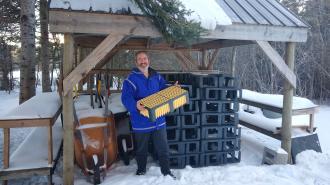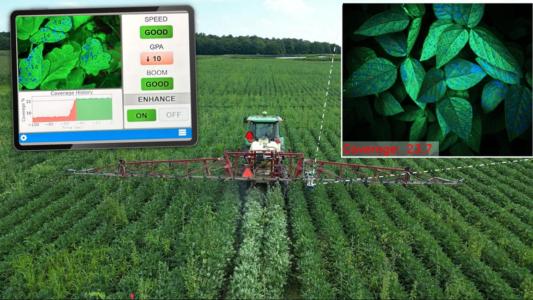On a brisk September morning, Brian Palik’s footfalls land quietly on a path in flickering light, beneath a red pine canopy in Minnesota’s iconic Northwoods. A mature red pine, also called Norway pine, is a tall, straight overstory tree that thrives in cold winters and cool summers. It’s the official Minnesota state tree and a valued target of its timber industry.
But red pine’s days of dominance here could fade. In coming decades, climate change will make red pine and other Northwoods trees increasingly vulnerable to destructive combinations of longer, warmer summers and less extremely cold winters, as well as droughts, windstorms, wildfires and insect infestations. Climate change is altering ecological conditions in cold regions faster than trees can adapt or migrate.
Palik, a forest ecologist with the US Department of Agriculture’s Forest Service Northern Research Station, stops and points to a newcomer under the red-pine canopy: a broadleaf deciduous tree, bitternut hickory, as high as an elephant’s eye at about 10 feet tall and eight years old. “It’s doing really well,” he says.
This bitternut hickory probably shouldn’t be thriving in the Cutfoot Experimental Forest in north-central Minnesota, near Grand Rapids. It likely began as a seedling in a nursery in Illinois, to the south, where deep freezes are less extreme. Normally, if a southern-adapted seedling is planted in an unsuitably cold climate like this one, it can risk frost damage and its survival is threatened. But the newcomer’s lush, green foliage exudes good health.
It is a promising sign in a project that aims to keep forests growing in a warming world.
In the Cutfoot Experimental Forest in 2016, the Forest Service planted seedlings of eight tree species from seeds, collected from woods up to several hundred miles farther south, as part of an experiment that Palik manages. Four species are native to this northern region: eastern white pine, northern red oak, bur oak and red maple. Four species are uncommon or nonnative: white oak, bitternut hickory, black cherry and ponderosa pine.
Two decades back, these southern seedlings likely would have struggled to flourish here. Today, Palik and his team can see the success of almost all the southern trees they planted. “They are going like gangbusters,” he says, “which is indicative that the climate is right for them,” although the researchers don’t know about the seedlings’ long-term health yet. In seven of the eight species, the survival rate has been 85 to 90 percent.
“The climate typical of southern Minnesota from 20 years ago is now in northern Minnesota,” Palik says. Climatic conditions have moved about 200 miles north in just two decades.
Palik’s project is an experiment in forest assisted migration, the relocation of trees to help woodlands adapt and flourish despite the heating of their habitats from climate change. Foresters advocating assisted migration are typically not aiming to save specific species — instead, by moving trees, they want to help sustain productive forests for multiple benefits such as carbon storage, water filtration, wildlife habitat, recreational beauty and timber.
Experimenting with assisted migration calls for a different way of thinking about nature. Whereas ecological restoration typically looks to the past for cues on repairing degraded places, foresters exploring assisted migration are planting warmer-climate trees that could have a better chance of thriving under warmer future conditions.
Forestry companies have long moved trees around to improve timber production on privately held land. But forest managers have so far been cautious about assisted migration projects for conservation aims on public land. Most of their projects have been experimental and small in scale, typically moving tree populations relatively short distances to the northern parts of their native ranges.
Now, though, assisted migration research for conservation is getting bolder with growing concerns about future forest disruption from climate change. And the movement is growing internationally, with research happening in Spain, Canada and Mexico. Today, Palik’s study is one of 14 research projects in a network named Adaptive Silviculture for Climate Change (ASCC). Most foresters who are experimenting with assisted migration are planting trees farther north or planting trees from lower elevations at higher elevations.
Sites across North America include western larch-mixed-conifer forests in the Flathead National Forest in Montana; diverse pine-hardwood woodlands at the Jones Center at Ichauway in Georgia; spruce-fir forests of the Colorado State Forest; and mixed-pine-hardwood forests of the Petawawa Research Forest in Ontario, Canada. Some Forest Service scientists, including Palik, expect that assisted migration will transition from a subject of research to a standard management strategy.
In line with the trend, the Forest Service and many other federal and state agencies are looking at revising their policies to accommodate this strategy. The US Fish and Wildlife Service, for instance, is considering allowing forestry managers to relocate species beyond their historical range.
Artificially moving a forest, some biologists say, has risks. Relocated species might become invasive or disrupt the ecological balance of the forest. But, says Palik, “the risk of not trying to move species for climate change is larger.”
Diversify or decline
Assisted migration was first proposed in the 1980s when some biologists anticipated that habitat conditions could change too fast for species to keep pace. Recent proposals have called for relocating endangered species to new habitats where they would have a better chance of thriving: Mexican gray wolves to northern parts of Arizona, New Mexico or Texas, for example, or Karner blue butterflies farther north from southern Michigan.
Palik and other forest scientists, though, are working on a different conservation solution. They want to save stressed forests from further decline or even disappearance by planting large numbers of more southern-climate-adapted trees, thereby diversifying woodlands so their canopies can survive.
“Forests die fast and grow slowly,” says Lee E. Frelich, a forest ecologist with the University of Minnesota Center for Forest Ecology. As climate change continues, he says, some forests could vanish, replaced by encroaching grasslands that do not provide the types of wildlife habitat and other benefits that healthy forests do. “Your only option in that case,” he says, “is to bring in new species or live with whatever nature does,” which — in cases of extreme climate change — “is likely to be brushy vegetation and not be a forest for quite some time.”
Climate change has already contributed to rapid forest losses. In recent decades, forests on every forested continent have suffered intense heat waves and drought exacerbated by climate change, says Henrik Hartmann, an ecophysiologist at the Julius Kühn-Institute for Forest Protection in Germany and lead author of an overview of forest die-offs in the 2022 Annual Review of Plant Biology.
Extremes are a natural part of a forest’s life history, and trees typically adapt to them — but this time is different. “These extremes were enough to bring trees to the edge or beyond the edge of functioning,” Hartmann says.
Cold-winter lands like the Minnesota Northwoods are disproportionately affected by climate change, which is causing shorter winters, drier summers and longer fire seasons.
Minnesota has one of the coldest climates in the Lower 48 United States because it is strongly influenced by the Arctic. But the Arctic has warmed four times faster than the rest of the Earth since 1979, and the state now has the Lower 48’s fastest-warming winters. Since 1970, average winter temperatures in Minnesota have increased by nearly 5 degrees Fahrenheit.
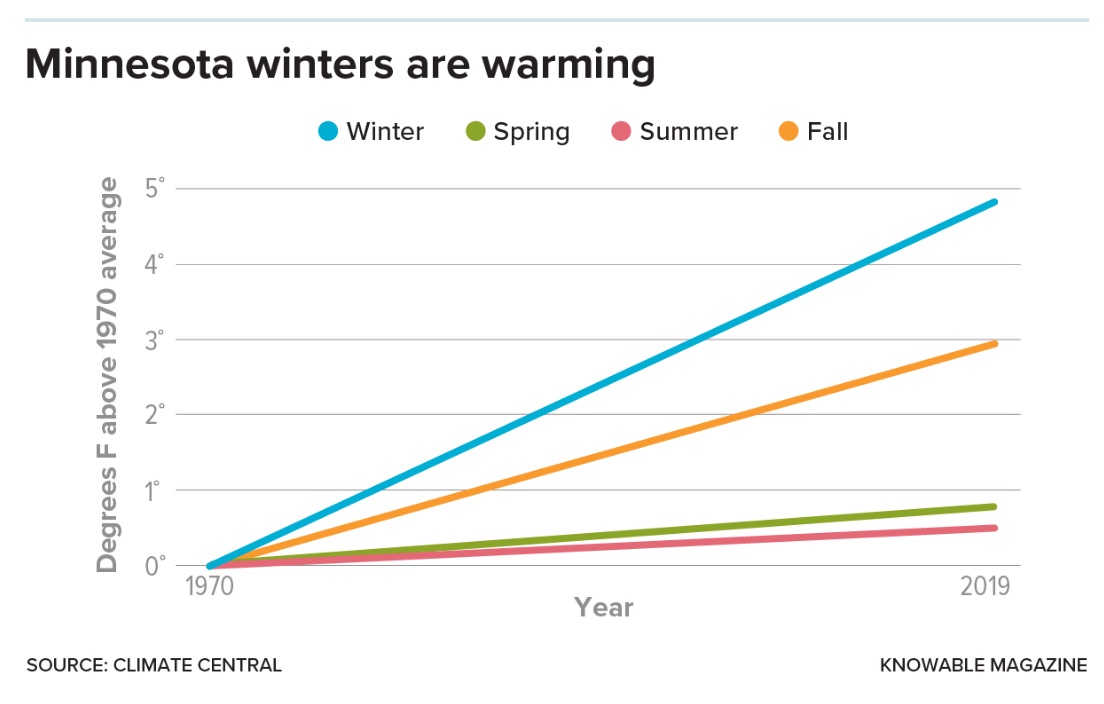
Minnesota is also unusual for having four major plant boundaries within its borders: mostly cold-climate conifers in the Northwoods; temperate deciduous trees such as oaks and maples in the state’s middle and southeast; and former prairie grasslands and aspen parklands, these days predominantly farmland, to the west and southwest.
Now these boundaries are blurring. Temperate deciduous trees have begun invading the understory of conifers in the Northwoods because the warming climate has begun favoring them. Many Northwoods tree species, including red pine, are likely to lose more and more of their livable southern range as warming continues. When Northwoods trees fade from the scene in the southern range, researchers worry that the migration of deciduous trees to replace them will happen far too slowly for healthy, continuous forest canopies to survive.
At the same time, the ecology of the Northwoods is becoming more tenuous. As climate change continues, giant swaths of northern conifers are increasingly likely to collapse suddenly — over just a few years — from combinations of climate-driven drought, insect infestations and other stresses. Many northern native tree species might not grow back there because they would no longer be suited to the region’s changed climate.
Recently, Frelich and his colleagues studied a range of possible impacts from rising temperatures — largely dependent on carbon dioxide emission scenarios — on Minnesota forests by 2070. A rise of 1 degree Celsius above 1979-to-2013 average temperatures would allow broadleaf forests to further invade the Northwoods. With a 6 degree C rise, prairie would cover most of Minnesota, with only broadleaf forests surviving in the northeast corner.
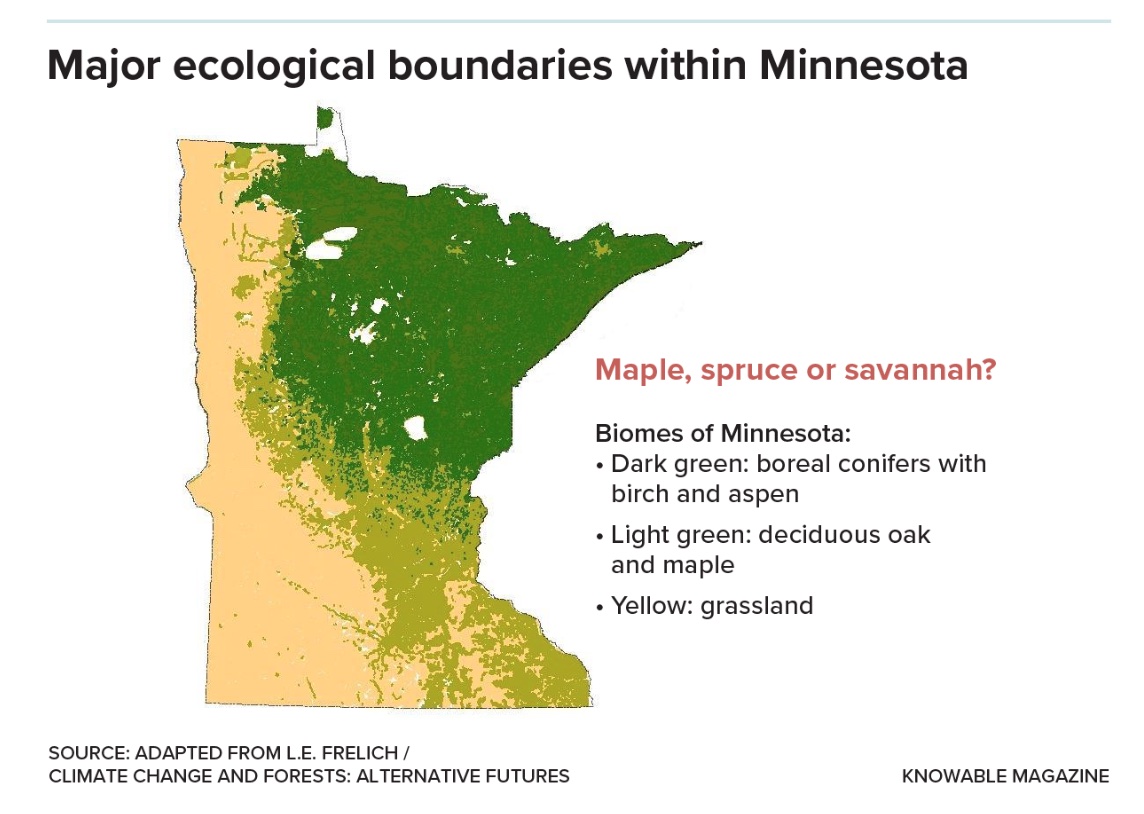
Speeding up nature’s pace
Worldwide, trees move north and south and up and down mountains in long-term response to changing climate, their seeds dispersed by winds and carried by animals.
It can take a millennium for many forests to reach equilibrium in a new location, according to Hartmann. That’s not really a problem for the forests, which eventually migrate; instead, it’s a problem for people. On weekends in Germany, people walk in the hills and mountains and through the forests, which is very popular as recreation, says Hartmann. But now, “They’re all shocked — it looks like the moon, and the forest is dead.”
Waiting for new trees could take a while: Some tree species reach an age of 25 years before making their first seeds. “If we want all of the services [of forests], similar to what we had only a decade ago, then we may want to think about getting a few more options,” Hartmann says. “We should think about conserving a forest and not the forest that we know.”
That’s what Julie Etterson, an evolutionary geneticist at the University of Minnesota Duluth, had in mind when she cofounded the Forest Assisted Migration Project with Meredith Cornett, then of the Nature Conservancy, and David Abazs of the University of Minnesota Extension. Etterson was worried that native tree decline would create openings for invasive plant species and sought a way to preserve forests by gradually moving in southern trees. The Forest Assisted Migration Project aims to build a regional market for climate-adapted tree seedlings grown by local farms and nurseries based on principles of Etterson’s and Cornett’s research.
For one study, Etterson and colleagues acquired seedlings of red oak and bur oak grown from seeds collected in two climatic zones: one in northern Minnesota and one nearer the center of the state. Workers planted the seedlings on 16 sites in two northern seed zones as part of a Nature Conservancy reforestation project, and the trees were measured for three years. Red oak sourced from southern seeds — adapted to a slightly warmer climate — had higher survival, faster growth and other advantages compared with the northern type. Results for the southern bur oak, while more mixed, were also generally better than the northern bur oak.
Etterson’s experiments in assisted migration, done in collaboration with the Nature Conservancy and public and tribal agencies, provide a scientific foundation for including climate-adapted trees in reforesting efforts underway in the state: In 2023, for example, the Nature Conservancy planted 1.4 million seedlings across northern Minnesota as part of a multi-partner goal to have 10 million seedlings planted on public lands by the end of 2024. As they plant, workers select about three-quarters of seedlings in the traditional way — seeds are collected from a climate zone, grown to seedlings in that zone, and planted in that zone, too. The rest of the seedlings come from parent seeds collected in forests farther south.
“We are using the ones that science tells us are in the best position to be climate adaptation winners,” says Chris Dunham, associate director of forest resilience with the Nature Conservancy in Duluth. But they are turning the dial slowly, he says, “because there’s also plenty of unknowns dealing with natural systems.”
The dial is turning slowly for another reason: Nurseries in the state can’t provide enough local seedlings to meet growing demand for “climate-smart” trees. And so Abasz started organizing a broader supply chain of seed collectors, seedling growers and buyers, and set a five-year goal of expanding the Farm & Forest Growers Cooperative to a network of 100 farmers and nurseries to each grow 10,000 southern-adapted, locally grown tree seedlings per year. The program would then expand the number of purchase agreements with restoration agencies such as county forestry departments.
Through all of this, the Forest Assisted Migration Project would recommend which young trees to plant where, designating them as green, yellow or red. The designations are based on Etterson’s research findings, input from experts and different kinds of assisted migration.
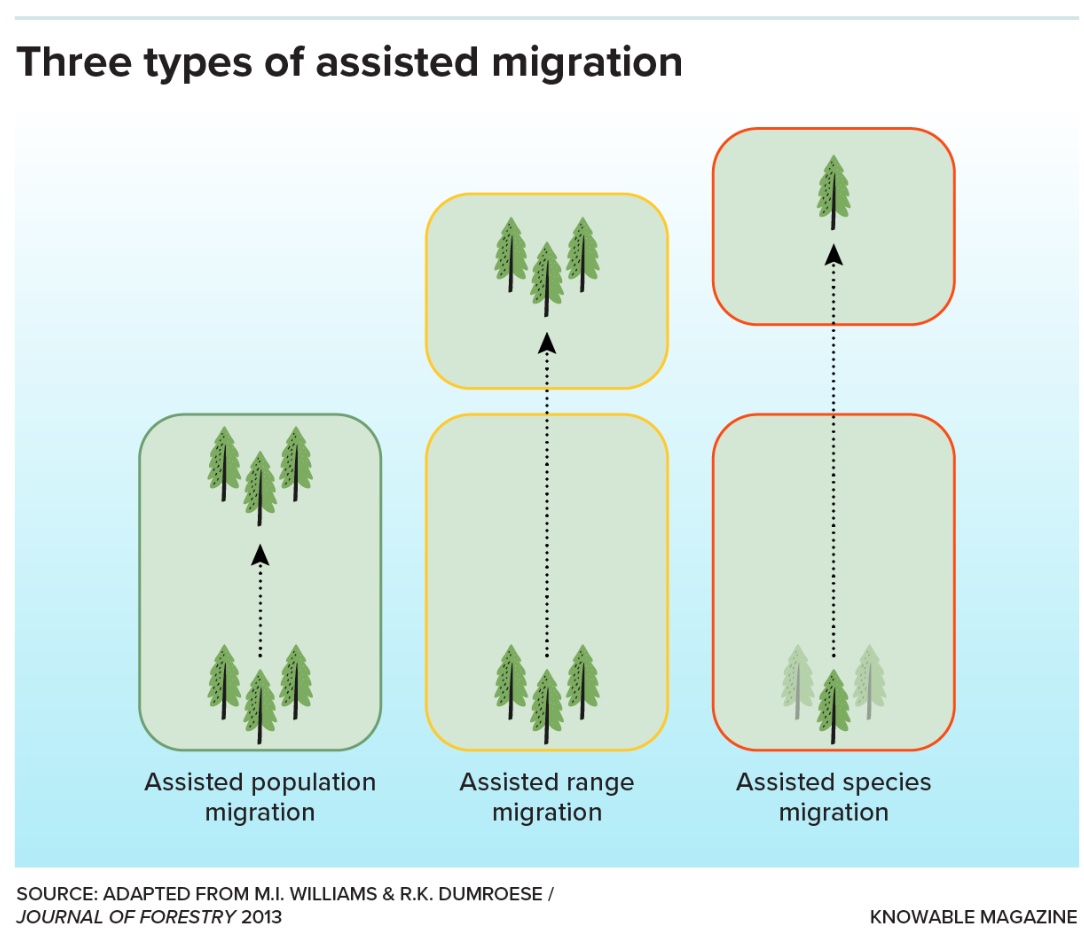
Seedlings designated as green are considered safe to plant in northern Minnesota because they already thrive there. Southern seedlings of native species would be planted farther north but within their historical range. This is called assisted population migration.
Trees designated as yellow require more caution. This is assisted range migration — moving species beyond their current historical range to keep up with climate change. This process also mimics what natural seed dispersal might do. “These are species that may be just creeping in our area or have very small populations in our area,” says Abazs, such as Eastern hemlock and American beech.
These southern seedlings are more likely to become resilient trees. Among other things, the climate-adapted trees may bloom earlier in the year and end growth later in the fall, capturing longer periods of photosynthesis.
Finally, trees designated as red by the Forest Assisted Migration Project would be ones that could not naturally disperse seeds to northern Minnesota because the distance is too great. Relocating that category of tree would be considered assisted species migration. Seedlings from southernmost Minnesota or northern Iowa, for example, would be designated as red. “Those are ones that we are not entertaining at this point,” says Abazs.
A lesson from the ponderosa
One of Palik’s relocated species over at the Cutfoot Experimental Forest would have gotten a red rating by those guidelines. But Palik is placing bets on the tree as a future invaluable conifer for northern Minnesota.
Palik took ponderosa pine seedlings from seeds collected in northwest Nebraska, hundreds of miles to the south and west, and planted them in experimental plots for research purposes. Though only a fifth of them lived, the ones that survived have flourished. His experiment suggests that ponderosa pine — a tall, long-needled tree used for timber but adapted to warmer, dryer summers and more moderate winters — could someday thrive in northern Minnesota if red pine falls away.
Temperate broadleaf trees will continue to edge into the Northwoods, but they can’t replace the characteristic pinelands that define how many Minnesotans experience the region, Palik says.
Many forest managers could eventually face a choice: Consider moving southern trees into northern areas, or eventually wind up with fewer productive woodlands for timber and other uses.
It’s imperative, Palik says, that we work to maintain useful woodlands. “The forests at the end of the century are not going to be your grandfather’s forests,” he says. “But they’re going to be the forest your grandchildren inherit.”
This article originally appeared in Knowable Magazine, a nonprofit publication dedicated to making scientific knowledge accessible to all. Sign up for Knowable Magazine’s newsletter.

